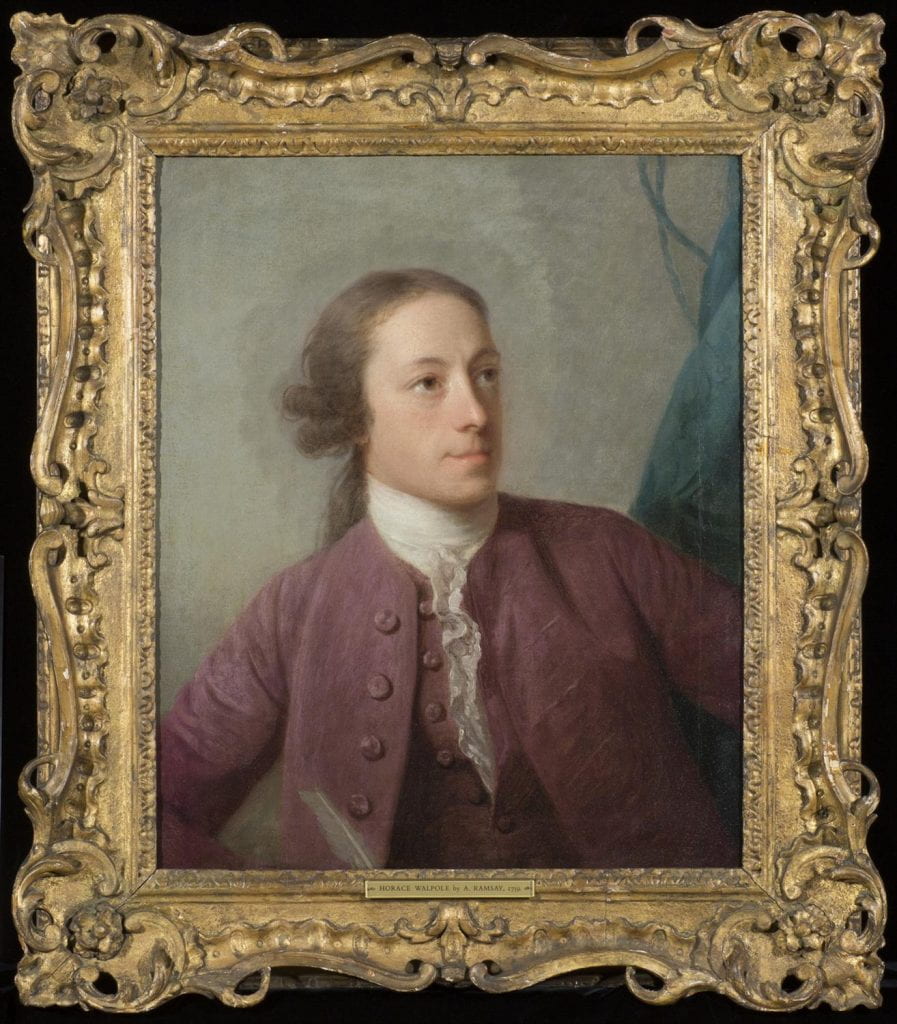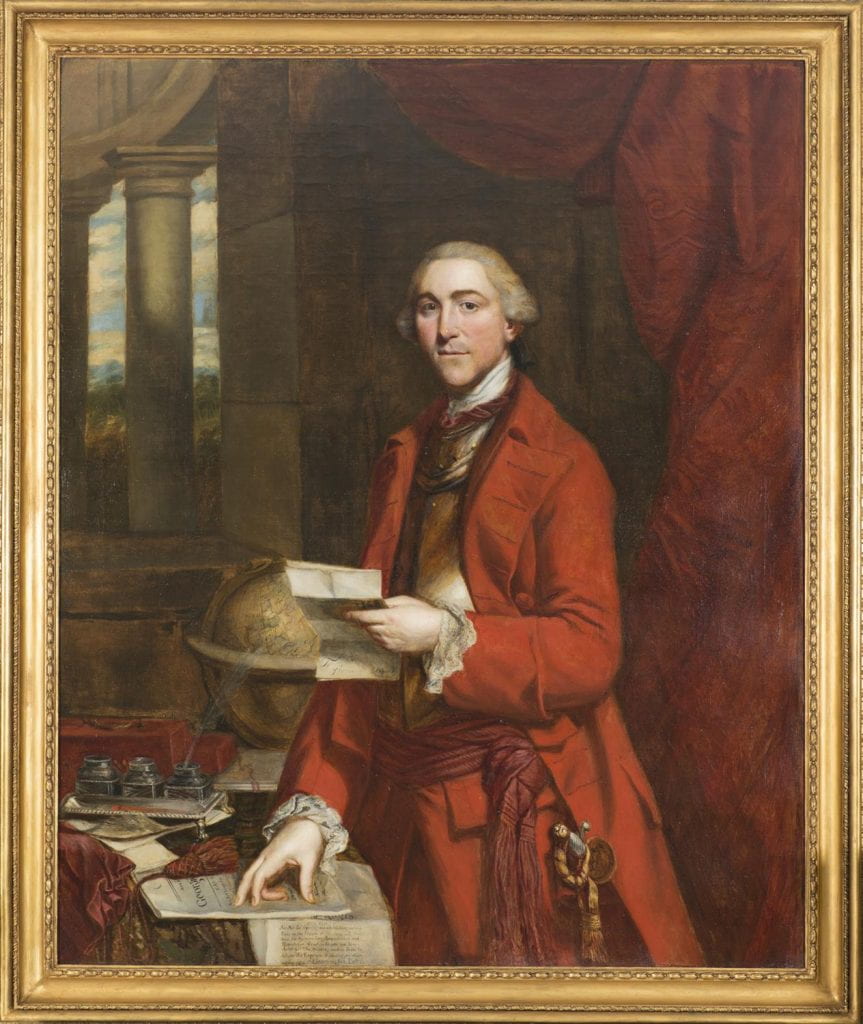Choices 24 and 25: Ramsay’s Portrait of Walpole and Berwick’s of Conway
by Wilmarth S. Lewis
“One day in the summer of 1931 Annie burr and I had tea at Nuneham Park with the dowager Lady Harcourt. Nuneham was a place of pilgrimage for me because it was the house I think Walpole most enjoyed visiting. He delighted in everything about it, its ‘own beauties’ its gardens, which he called ‘the quintessence of nosegays,’ and its talented owner, George Simon 2d Earl Harcourt and his wife who wrote verses.
Harcourt was an amateur artist who Walpole said etched landscapes ‘in a very great style’ and whose views of his other house in Oxfordshire, Stanton Harcourt, were ‘the richest etchings I ever saw, and masterly executed.’ Walpole begged Lady Harcourt in vain to let him print her verses, which he said were written ‘in a very natural style.’ I was eager to see ‘the paradise of earth’ and Walpole’s letters to Harcourt, fifty-seven in number, which were there. On our first visit Lady Harcourt asked the housekeeper to produce them, a request carried out with marked distaste. The housekeeper told us darkly that an American who said he was a professor came to see the letters years before and she was sure he had made off with some of them. The most common explanation for the disappearance of family papers in England is a fire; the second most common explanation is the visit from an American professor.
I didn’t touch the letters, but admired the portraits in oval frames about the library shelves, Locke, Pope, Gray and so on, including an unrecorded portrait of Horace Walpole, ‘By Gogain, after Allan Ramsay.” Since it was the custom in the eighteenth century to give copies of one’s portraits to friends it was not surprising to find Walpole at Nuneham, but in 1931 I was still uninitiated in the science of iconography and assumed the copy couldn’t be of Walpole because it doesn’t appear in the Toynbee’s edition of his letters. When a few years later I found in the house of a Walpole relation a second Gogain of Ramsay’s portrait inscribed on it frame ‘The Hon. Horace Walpole copied from an original picture of him at Nuneham,’ I was still too uninstructed to do more than wonder mildly about the original Ramsay.
I found it ultimately through the Agony Column of the Times when in 1936 my advertisement brought this letter:
Dear Sir, Accidently I heard you were interested in Strawberry Hill. My family and I have a larg [sic] number of painting and watercolors from the great sale and by inheritance. Angelica Kaufmans and Paul Sandbys. Aylesbury tapestries etc If you are sufficiently interested I shall be glad to show you some of them at least My grandfather and Anne Seymour Damer were close connections. Nothing for sale Yrs faithfully H. Campbell Jonhston
Campbell Johnston was a promising name, allied to the Argyll family in which were Lord Frederick Campbell, Walpole’s executor, and his sister Lady Ailesbury, Conway’s wife. They were uncle- and aunt-in-law of Sir Alexander Johnston of Carnsalloch, Dumfriesshire, the enlightened reorganizer of Ceylon early in the nineteenth century.
H. Campbell Johnston was one of the descendants, as I discovered when I called on him in Kensington. His flat (third floor back), his clothes, his chastened manner, indicated one of who had seen better days. He admitted that the Walpoliana did not belong to him, but to a younger brother, D. Campbell Johnston. However, he went on earnestly, his brother would show them to me at tea, and he did so a few days later in his big house in Hans Road. Also present in the drawing-room besides the elder brother was a younger sister. my entrance was irregular because on walking into the room I saw several objects from Strawberry Hill and acknowledged them by a cry of recognition before greeting my host. There are dead-pan collectors who suppress such cries hoping to pay less for the coveted objects, but I think I have gained by my undisguised delight on seeing them. In the drawing-room were Muntz’s sketch of Walpole in the library at Strawberry Hill, two drawings of Conway, Lady Ailesbury, and Mrs Damer, when a child, and two of Lady of Ailesbury’s needlework tapestries in silk. The flame of hope rose in the elder brother as my enthusiasm invested the family treasures with transcendent value. I was aware of this and also that in the bosom of the younger brother no friendly response stirred, a disappointment, since it was clear that his was the deciding voice in the family councils. The sister was amused by my and her elder brother’s eagerness to have something come of the call besides tea and by her younger brother’s evident decision that nothing should. I made notes of the Walpoliana, but not, unfortunately, of the conversation. My inquiries in 1937 and 1938 to the younger brother about Walpole’s letters to Lord Frederick Campbell received terse replies that he did not have them.
When I was in London in 1942 the Campbell Johnstons had disappeared from all works of reference and I did not pursue their Walpoliana until 1951 when, fortunately, i mentioned them to Owen Morshead who discovered immediately that the objects I saw in Hans Road had descended to Commander Colin Campbell Johnston, who was living at Brighton, and there they were in his drawing-room when I arrived for lunch in a few days. In answer to the question about other members of family who might own Walpoliana, my host suggested I write to the g=head of it, the Laird of Carnsalloch, Mr David Campbell Johnston. He replied that he had no Walpole letters, but kindly wrote out a list of contents of the five volumes of Lord Orford’s Works, 1798, a not uncommon work. As an afterthought he mentioned that he owned Ramsay’s portrait of Walpole. I urged him to get an appraisal from the most reputable dealers and auctioneers if he ever decided to part with it, but this gratuitous advice went unacknowledged. After a year I wrote again, sending a copy of my earlier letter, which I feared had gone astray. This time the Laird replied at once, saying there was no use in discussing the matter further unless I was prepared to give him £120 for the picture. When it reached Kingsley Adam’s office at the National Portrait Gallery in London en route to Farmington it was discovered that much of it had been cut away–how much appears from Ramsay’s preliminary sketch in the National Gallery , Edinburgh, that shows Walpole at his desk holding a quill pen, only the tip survives. Despite its mutilation, the portrait ranks among the best known of Walpole because Professor George B. Cooper used it on the dust jacket of the selection of Walpole’s letters he encouraged me to make for his large class at Trinity College, Hartford, and that is used in other classrooms as well.
The Laird of Carnsalloch informed a cousin in London, Miss Scholefield, that there was a mad American at Brown’s Hotel who would pay anything for Walpoliana and that here was a chance to see her Gainsborough of Henry Seymour Conway and repaint her dining room. Miss Scholefield wrote me she would be happy to show me the Gainsborough. I turned to Kingsley Adams for guidance and support. He had succeeded Hake as Director of the Portrait Gallery and the Gallery’s records of Conway’s portraits were in his brief case when we rang Miss Scholefield’s door-bell a few days later. Among the Conways portraits was one that had been exhibited at the New Gallery in 1890-91. It was signed “A. Berwick,” who was a copyist, according to Whitley’s Artists and Their Friends in England, 1700-1799. Miss Scholefield opened her door promptly. Miss Scholefield led Adams and me to the small dining-room and the commanding three-quarters-length portrait of Conway that dominated it. As its head and shoulders had been engraved for Lord Orford’s Works, 1798, they were familiar, but the engraving gives us only Conway the soldier wearing a cuirass; in the portrait he is also the statesman, the Secretary of State for the Southern Department that included the American Colonies. He is standing at a table on which is a red dispatch box, a copy of the bill, which he also fathered, for the repeal of the Stamp Act. A dark red curtain is at his back; a classical colonnade stretches away on his right. Could the picture be taken down to see what was on the stretcher? Polly screamed assent from the drawing-room and the picture was taken down, a precarious business with Adams standing on a light chair, his arms spread across the picture embracing the frame as he teased it off the hook while Miss Scholefield and I, squatting below, heaved it up with little cries of caution and apprehension. The picture and Adams safely down, we found on the stretcher “A. Berwick pinxit,” and the label of the Hanover Exhibition at the New Gallery in 1890-91. There was also a note that the picture belonged to “Mrs Campbell Johnston.” Everybody was relieved and delighted. The moment had come to cross the valley of reticence and talk money.
The two principals were what auctioneers call, “A Willing Seller and A Willing Buyer.” The latter advised Miss Scholefield to get the best professional advice for a valuation. She looked bank. I rolled off five possibilities: Agnew, Colnaghi, Leggatt, Christie’s, Sotheby’s.”
“Oh Sotheby’s!” “You know them?” “No, but I’ve always liked the name.”
I telephoned Vere Pilkington, at the time the senior partner of Sotheby’s. “Is he in a red coat?” he asked. “Yes.” “Bad luck, I’m afraid that will add £20.”
After the portrait reached Farmington I told Robert Vail, who was then Director of the New York Historical Society, that the Campbell Johnston family believed the original was painted for “the Town Hall of New York.” He kindly explored the matter and found that it was the people of Boston, not New York, who on 18 September 1765, voted their thanks to Conway and requested his portrait for Faneuil Hall. The picture reached it after a delay of nearly two years–while the copy was being made for Conway’s Family?–but the original was lost during the Revolution. The copy descended to Miss Scholefield, who wrote its new owner to say how happy she was it had found such a good home. Her letter concluded, ‘Polly send you the enclosed,” which was a snapshot of Polly himself.
Who painted the portrait? Family tradition is not necessarily wrong and a very important critic has said the head at least may be by Gainsborough. The pose is similar to Gainsborough’s portrait of Conway owned by the Duke of Argyll, head of the Campbell clan. The trees seen through the colonnade have a Gainsboroughesque look. My guess is that before Conway sent his portrait to Boston he had the copy made in Gainsborough’s studio where I understand A. Berwick was employed and of course I I like to think that that the head was painted by the master.
Lewis, Wilmarth S. Rescuing Horace Walpole. New Haven and London: Yale University Press, 1978.
To see the full chapter from Rescuing Horace Walpole called “Choices 24 and 25: Ramsay’s Portrait of Walpole and Berwick’s of Conway” download or expand the link here:
 Loading...
Loading...
N.B. The collection of eighteenth- and early nineteenth-century British satires in the LWL’s collection have been cataloged in Orbis, Yale’s online library catalog, and through the Quicksearch Books+ interface, and digital images can be found in the Digital Collection.


